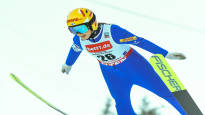On Wednesday, the Olympic Committee reported on the recent enhancements to the Winter Sports. Cross-country skiing support increased by 20,000 euros from last year. It is now 500,000 euros.
The hockey support remained the same, 480,000 euros. Freeski, which has emerged as Finland’s new successful sport in recent years, is part of the support program for top sports.
The financial situation of the ski association has been a hot topic for a long time. In April, the ski association announced its drastic measures regarding ski jumping and combined national team activities. The association cannot guarantee the national team athletes of those sports any kind of national team activity this training season.
The Olympic Committee received 120,000 euros for ski jumping and 170,000 euros for the combined event. The combined support was reduced by 30,000 euros.
– We want to secure the preparation of top athletes for Milano Cortina (2026 Olympics). All support decisions have clear, strict criteria, and there are changes one way or the other. However, we want to emphasize elite athletes in these, the head of the elite sports unit Matti Heikkinen says.
Cross-country skiing 500,000 e
Ice hockey 480,000 e
Freeski 180,000 e
Biathlon 150,000 e
Freestyle (bump descent) 95,000 e
Snowboarding 150,000 e
Hill jumping 120,000 e
Combined 170,000 e
Figure skating 135,000
Does the weak economic situation affect the skiing pot?
Heikkinen says that the Olympic Committee looks at the prospect of success when granting subsidies. They see that cross-country skiing, ice hockey and freeskiing have the best chances to compete for medals at the 2026 Milan Winter Olympics.
In the previous Winter Games, out of Finland’s eight medals, cross-country skiing accounted for six and ice hockey for two.
– The criteria for the top sport includes that there must be a clear prospect of success for several medals in the next Olympics. In that sense, it’s easy to make decisions, because if you look at Beijing’s success and previous work, we have a clear prospect of success in snow sports as well, Heikkinen refers to cross-country skiing.
– I see that, in addition to medals, winter sports have the kind of expertise that can be widely used in Finnish top sports. These supports should not be pitted against each other, but should be seen as a good thing from the point of view of Finnish elite sports as a whole, he adds.
The grant is therefore awarded according to success. Has the fact that the ski association’s financial situation is bad influenced the decision?
– We want to secure the training of top athletes for Cortina. Of course, then the whole is looked at and support is directed accordingly. That is the basic task of an elite sports unit, and we must do it together with the sports. Let’s go according to the criteria.
Top athletes are taken care of
Last winter Jenny Rautionaho (ski jumping) and Minja Korhonen (combined) each reached the top three in the World Cup once. Otherwise, Finnish success in these sports was poor.
– Of course, success is what we aim for in elite sports. The overall situation around skiing is challenging, and for our part, we are working and providing support so that the top athletes’ preparation for Cortina would be successful.
– In skiing, national team activities have traditionally been of great importance. It is important that top athletes commit to the activity.
Are these subsidies enough to save ski jumping and combined summer activities?
– The sport itself is responsible for national team activities. The aim is to secure the support of top athletes towards national team activities, Heikkinen repeats.
An expert understands less support
Combined was previously one of the most successful winter sports in Finland. Until three years ago Ilkka Herola won silver in the World Cup, but in the last World Cup season, no Finnish man reached the top three in the competitions.
The subsidy for enhancing the sport is therefore now 30,000 euros less than a year ago.
Sports’ combined expert Petter Kukkonen says that the situation is unfortunate, but sees logical reasons behind the decision.
In the next Olympics, the number of combined competitors will drop considerably. While in the past there could have been four athletes in an individual competition, in the future there will only be three.
– I believe that the Olympic Committee has used this as a basis. A smaller group prepares and participates in the Olympics. This has not happened in other sports, but combined is an exception.
In the next Olympics, there will not be a traditional four-athlete team race in the combined event either. In Milan, the team competition is held as a double relay.
A year ago, seven combined athletes were under the national team’s training season camp support, but now only four. Kukkonen believes that this has been important in terms of subsidies for enhancing the combined pot.
– The initial goal of the Olympic Committee or the elite sports unit is not to save the sports alone, but that includes the role of the sports association. When the ski association is in trouble, the athletes’ own investment and the background support of the clubs is important. Sports funding will drop significantly in the coming years, so it is logical that the elite sports unit invests more clearly in the elite.
